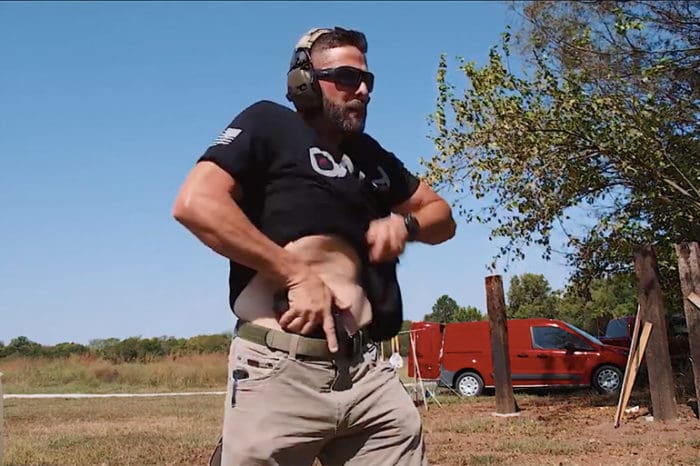By Dylan Casey
I first started to carry a firearm daily around six years ago. About a year ago I switched to the appendix carry position. I have to say it makes carrying more comfortable and more concealable. Not to mention I can draw much faster. At GunSpot I have learned a great deal from Chief Instructor Grant LaVelle. We decided to do a project with Grant to teach a proper safe way to draw your gun from the appendix position.
The first thing to consider for any form of concealed carry is to have a proper gun belt. Gun belts are stiff and often reinforced. This ensures there’s no sag, giving you a more comfortable, concealable carry with a consistent draw.
Second, you will want a quality holster. We prefer a Kydex holster with positive retention. In this video we used the OATH holster paired with Grant’s GLOCK 17.
When considering the actual draw stroke from appendix carry, the first thing you have to do is clear the cover garment. In other words, you need to get your shirt up and out of the way so you can get a good initial grip on your gun. Grant teaches to grab the section of your shirt right over the gun, then to lift and rotate it across your body away from your gun. This prevents snagging your strong hand thumb on your garment as you move it toward your pistol’s grip.
When it comes to gripping the gun, in your training make sure you focus on getting a good, solid initial grip on the pistol. That means having the web of your hand placed high on the grip. If you have to, as you practice, make this a stopping point and slow your draw during dry fire practice drill this home.
It’s important to build good muscle memory for your grip. That way when the pressure is on and you have to draw fast, you will do it correctly and consistently. Don’t let yourself have a bad grip before you draw, and then try to fix it once the gun is out of the holster. That will be a recipe for disaster in a defense situation.
Once you have a firm grip, draw the gun up and rotate the muzzle toward your target as you move the gun up. Start the process of getting the gun pointed downrange as soon as it clears the holster. You want the gun pointed at the threat as soon as possible.
From that point, Grant teaches a high sight press. To use a high sight press, you draw the gun, rotate the muzzle at the threat, and lift it up to your chest all while keeping it close to your body. Then once the gun is up with both hands press it out onto the threat, pressing the gun out from this height will help you see your front sight as you present out onto the target.
One of the reasons Grant teaches to keep the gun close to you until you press out on the target is so that the gun isn’t something easy for the threat to knock from your hand or grab. If it’s close, you retain control of it. After the gun is out and the sights are on target that’s when you fire a shot if the situation needs it.
Check out our full video above to see Grant explain this in action. Remember to practice as often as you can. Practicing with an unloaded weapon at home is where a safe, efficient, and fast draw stroke is built. So get a good belt, a good holster, and start getting in some reps.
Dylan Casey is the creative director of GunSpot.com.
